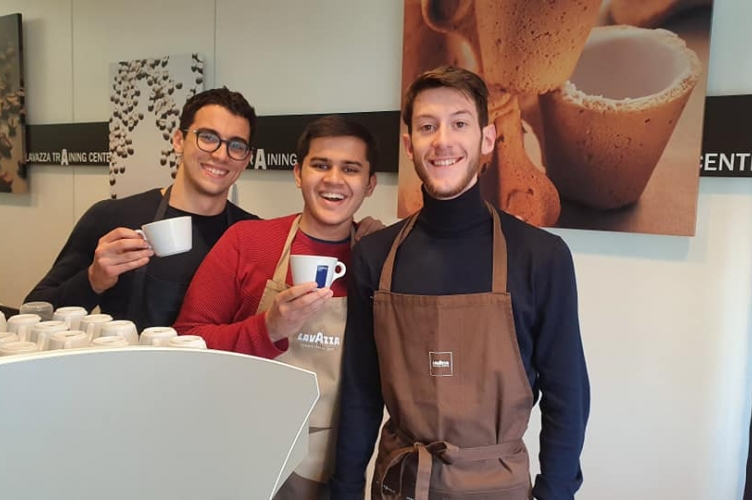Lavazza Training Centre welcomes ESCP Master in International Food and Beverage Management students.
Two students attending the Master in IFBM, Paola De Luca and Luca Rodari, wrote about their 2 days at the Lavazza Training Center:
Thanks to the Master in International Food & Beverage Management at ESCP Business School we visited the Lavazza Training Centre with a group of 40 keen foodies. When we arrived at the Settimo Torinese site we had the pleasure of experiencing a two-day full immersion into the world of coffee. This commodity has always been the centre of the world’s attention: coffee is the 3rd most traded commodity worldwide. Many consider it almost a staple and it has always been able to win people’s hearts: indeed, the demand for coffee is constantly growing heedless of recessions.
Our journey started with a warm, Italian style welcome and a good espresso. At the Training Centre we saw a huge number of employees, whose average age is no higher than 40. As young trainees, we had the pleasure to meet Giulia and Michele, senior trainers and brand ambassadors for Lavazza. Two days may seem a short time to summarize the huge amount of information on coffee, but Giulia and Michele had their ace in the hole: practice and training. In fact, we experienced what a Lavazza barista has to know from the beginning: how to make a good bean become a great espresso. Starting from the life cycle of coffee, up to the botanical features and varieties of the coffee plant, we had the opportunity to enhance our knowledge of the Lavazza method: in particular, the roasting process that is the result of know-how that has been passed on from generation to generation. This has led Lavazza to become one of the most successful examples of an Italian family-owned business.
Being that coffee is a fundamental part of the Italian routine, Lavazza has always aimed to share the culture of drinking really good coffee. In fact, who can actually say what is hidden inside a single cup of espresso?
As IFBM students we want to share what we learnt at Lavazza: coffee is a tropical-climate plant, discovered in Ethiopia, and nowadays it’s cultivated in the so-called coffee belt. This area is, culturally and historically, the most productive territory for coffee which includes Central (13%) and South America (44%), Africa (11% esp. Ethiopia where the domestic consumption is higher than the export rate) and a part of Asia (32% Indonesia and Vietnam, whose growers are very skilled in the harvesting processes). There are two common coffee species that result in a high-quality product: Coffea arabica and Coffea canephora (known as robusta). The price of both species is regulated by the coffee market exchange: the arabica variety is listed in New York while the robusta in London. Lavazza has been using both these varieties in order to create the perfect blend to win over its customers.
Giulia and Michele guided us in the daily routine of a coffee panel so we could try out the sensorial peculiarities of both species. Through cupping it is possible to experience a wide variety of flavors and identify any defects. The SCAA (Specialty Coffee Association) has developed a fundamental tool for panels: the coffee aroma wheel. Beyond coffee’s analytical aspects, customer perception of this beverage is highly influenced by the various brewing methods. In fact, coffee’s image has been shaped by a huge variety of cultures and trends.
A major part of our experience was focused on the different methods for coffee preparation and tools. For example, contrary to the 9-bar Italian espresso, typical Turkish coffee has been traditionally brewed with a mixture of spices and heated through direct contact with hot sand. In the coffee lab at the Training Centre we experienced all these methods of coffee preparation, based on different infusion times, among which the most popular are: Aero Press, Chemex and French press. These methods result in diverse coffee styles: a relevant aspect is that the filter coffees rely exclusively on atmospheric pressure whereas a common moka brews on a 2-atmosphere pressure. These elements are a fundamental part of coffee quality alongside good quality management. But, what’s management without a deep knowledge of the product?
Thanks to ESCP Business school we had the extraordinary opportunity to experience and learn more about this singular product while having fun. As one of the most popular Lavazza advertisements states: “Coffee is a pleasure, if it’s not good where’s the pleasure?” Although we’re still waiting to leave for our semester in Paris, this experience had great added value for a set of truly engaged young, international future professionals sharing the same love for food.
Paola De Luca & Luca Rodari
Campuses



